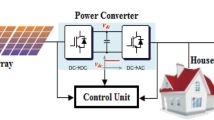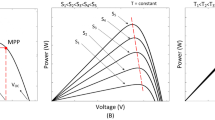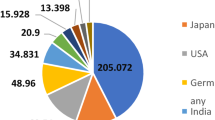Abstract
Global analysis of power system markets project frequency regulation as one of the most profitable ancillary services. It is associated with second-to-second balance of load and frequency within a control area and acquires a principal role in enabling power interchanges while offering better conditions for electricity exchange. In the light of the above, a novel control strategy, namely salp swarm algorithm (SSA)-based model predictive controller, is proposed for frequency regulation of an unequal two-area realistic power system, incorporating solar thermal power plant and conventional thermal plant. Governor dead band, generation rate constraint and transport delay are considered in each control area. Over the past few years, model predictive controller (MPC) has come forward as a prediction-based control strategy for stabilizing dynamical systems while considering non-linearities, system uncertainties and constraints. The MPC parameters are optimized using SSA. The performance of the proposed approach is validated by comparing the dynamic time responses of SSA-optimized MPC with the other SSA-optimized conventional controllers, namely PID, FOPID and cascade PIDN-FOPID controller. The simulation result analysis shows that the proposed optimal MPC outpaces the conventional controllers with respect to peak overshoot, undershoot and settling time of the time responses. A comparative study of various objective functions indicates that, as compared to other indices, integral square error is better for the considered test system. Further, sensitivity analysis reveals the robustiousness of MPC parameters obtained at nominal values and hence is not required to be retuned, against variations in system loading and inertia constant.









Similar content being viewed by others
Abbreviations
- \( f \) :
-
Considered system frequency (Hz)
- \( i \) :
-
Referred subscript to area i, \( i \) = 1, 2
- \( T_{12} \) :
-
Synchronizing coefficient
- \( \Delta P_{Di} \) :
-
Load variation in area \( i \) (p.u.)
- \( T \) :
-
Simulation time (s)
- \( \Delta f_{i} \) :
-
Frequency change in ith area (Hz)
- \( D_{i} \) :
-
ΔPDi/Δfi (p.u. MW/Hz)
- \( K_{si} \) :
-
Gain of solar field of ith area
- \( B_{i} \) :
-
Frequency bias constant of ith area
- \( \pi \) :
-
pi
- \( K_{pi} \) :
-
1/Di (Hz/p.u. MW)
- \( H_{i} \) :
-
Inertia constant of area \( i \) (s)
- \( \beta_{i} \) :
-
(Di + 1/Ri); area frequency response characteristics of ith area
- \( R_{i} \) :
-
Speed regulation parameter of governor of ith area (Hz/p.u. MW)
- \( \Delta P_{\text{tie}} \) :
-
Incremental tie-line power deviation amid area 1 and area 2
- \( T_{gi} \) :
-
Time constant of steam governor for thermal power plant in ith area
- \( K_{pfi} \) :
-
Proportional gain of FOPID part of PIDN-FOPID cascade controller for ith area, i = 1, 2
- \( \mu_{i} \) :
-
Order of differentiator of cascade PIDN-FOPID controller in ith area, i = 1, 2
- \( T_{ti} \) :
-
Time constant of steam turbine for thermal power plant in ith area
- \( T_{gsi} \) :
-
Time constant of steam governor for STPP in ith area
- \( a_{12} \) :
-
Area capacity ratio
- T pi :
-
2H i /f/D i
- T o :
-
Working fluid outlet temperature of solar field (°C)
- T i :
-
Working fluid inlet temperature of solar field (°C)
- T e :
-
Environmental temperature (°C)
- I :
-
Solar irradiance (W/m2)
- v :
-
Pump flow rate (m3/s)
- A :
-
Surface area of the collector
- C :
-
Heat capacity of the working fluid (J/K)
- η 0 :
-
Solar field collector efficiency
- U L :
-
Total heat loss coefficient (W/m2 K)
- T ri :
-
Reheat steam turbine time constant of ith area (s)
- K ri :
-
Reheat coefficient of steam turbine of ith area
- K pri :
-
PID, FOPID, PIDN-FOPID proportional gain for ith area, i = 1, 2
- K ini :
-
PID, FOPID, PIDN-FOPID integral gain for ith area, i = 1, 2
- K dei :
-
PID, FOPID, PIDN-FOPID derivative gain for ith area, i = 1, 2
- N i :
-
PIDN-FOPID derivative filter coefficient for ith area, i = 1, 2
- K dfi :
-
Derivative gain of FOPID part of PIDN-FOPID cascade controller for ith area, i = 1, 2
- K ifi :
-
Integral gain of FOPID part of PIDN-FOPID cascade controller for ith area, i = 1, 2
- λ i :
-
Order of integrator of cascade PIDN-FOPID controller in ith area, i = 1, 2
- T si :
-
Solar collector time constant of ith area
- T tsi :
-
Time constant of steam turbine for STPP in ith area
References
Sivanagaraju S, Sreenivasan G (2017) Power system operation and control, 255–362, 19th edn. Pearson, India
Uma Rao K (2016) Power system operation & control, 185–294, 3rd edn. Wiley, India
Ibraheem, Kumar P, Kothari DP (2005) Recent philosophies of automatic generation control strategies in power systems. IEEE Trans Power Syst 20(1):346–357
Pandey SK, Mohanty SR, Kishor N (2013) A literature survey on load–frequency control for conventional and distribution generation power systems. Renew Sust Energy Rev 25:318–334
Nanda J, Mangla A, Suri S (2006) Some new findings on automatic generation control of an interconnected hydrothermal system with conventional controllers. IEEE Trans Energy Convers 21:187–194
Hota PK, Mohanty B (2016) Automatic generation control of multi-source power generation under deregulated environment. Int J Electr Power Energy Syst 75:205–214
Das DCh, Roy AK, Sinha N (2012) GA based frequency controller for solar thermal–diesel–wind hybrid energy generation/energy storage system. Electr Power Energy Syst 43:262–279
Bevrani H, Ghosh A, Ledwich G (2010) Renewable energy sources and frequency regulation: survey and new perspectives. IET Renew Power Gener 4(5):438–457
Buzas J, Kicsiny R (2014) Transfer functions of solar collectors for dynamical analysis and control design. Renew Energy 68:146–155
Sharma Y, Saikia LC (2015) Automatic generation control of a multi-area ST–thermal power system using Grey Wolf optimizer algorithm based classical controllers. Int J Electr Power Energy Syst 73:853–862
Saha A, Saikia LC (2017) Utilisation of ultra-capacitor in load frequency control under restructured STPP-thermal power systems using WOA optimised PIDN-FOPD controller. IET Gener Transm Distrib 11(13):3318–3331
Rajbongshi R, Saikia LC (2017) Combined control of voltage and frequency of multi-area multisource system incorporating solar thermal power plant using LSA optimised classical controllers. IET Gener Transm Distrib 11(10):2489–2498
Chandra Saikia Lalit, Nanda J, Mishra S (2011) Performance comparison of several classical controllers in AGC for multi area interconnected thermal system. Int J Electr Power Energy Syst 33(3):394–401
V. Shanmuga Sundaram, T. Jayabarathi (2011) Load frequency control using PID tuned ANN controller in power system. In: 1st international conference on electrical energy systems, pp 269–274
Kumar Sahu Rabindra, Sidhartha Panda, Kumar Rout Umesh (2013) DE optimized parallel 2-DOF PID controller for load frequency control of power system with governor dead-band nonlinearity. Electr Power Energy Syst 49:19–33
Dahiya P, Sharma V, Naresh R (2015) Solution approach to automatic generation control problem using hybridized gravitational search algorithm optimized PID and FOPID controllers. Adv Electr Comput Eng 15(2):23–34
Ersdal AM, Imsland L, Uhlen K (2016) Model predictive load-frequency control. IEEE Trans Power Syst 31(1):777–785
Arya Yogendra (2019) AGC of restructured multi-area multi-source hydrothermal power systems incorporating energy storage units via optimal fractional-order fuzzy PID controller. Neural Comput Appl 31:851–872
Dahiya P, Sharma V, Naresh R (2016) Automatic generation control using disrupted oppositional based gravitational search algorithm optimized sliding mode controller under deregulated environment. IET Gener Transm Distrib 10(16):3995–4005
Abd-Elazim SM, Ali ES (2018) Load frequency controller design of a two-area system composing of a PV grid and a thermal generator via firefly algorithm. Neural Comput Appl 30:607–616
Seyedali Mirjalili, Mohammad Mirjalili Seyed, Andrew Lewis (2014) Grey wolf optimizer. Adv Eng Softw 69:46–61
Faris Hossam, Aljarah Ibrahim, Al-Betar Mohammed Azmi, Mirjalili Seyedali (2018) Grey wolf optimizer: a review of recent variants and applications. Neural Comput Appl 30:413–435
Seyedali Mirjalili (2015) The ant lion optimizer. Adv Eng Softw 83:80–98
Patel Nimai Charan, Sahu Binod Kumar, Bagarty Durgesh Prasad, Das Pranati, Debnath Manoj Kumar (2019) A novel application of ALO -based fractional order fuzzy PID controller for AGC of power system with diverse sources of generation. Int J Electr Eng 56(3):1–23
Mirjalili S, Lewis A (2016) The whale optimization algorithm. Adv Eng Softw 95:51–67
Saremi Shahrzad, Mirjalili Seyedali, Lewis Andrew (2017) Grasshopper optimisation algorithm: theory and application. Adv Eng Softw 105:30–47
Mirjalili Seyedali, Gandomi Amir H, Mirjalili Seyedeh Zahra, Saremi Shahrzad, Faris Hossam, Mirjalili Seyed Mohammad (2017) Salp swarm algorithm: a bio-inspired optimizer for engineering design problems. Adv Eng Softw 114:163–191
El Hadi Abdulbaset, Saad Zuomin Dong, Karimi Meysam (2017) A comparative study on recently-introduced nature-based global optimization methods in complex mechanical system design. Algorithms 10(4):120
Abido MA (2002) Optimal design of power-system stabilizers using particle swarm optimization. IEEE Trans Energy Convers 17(3):406–413
Yang XS, Gandomi Hossein (2012) A. Bat algorithm: a novel approach for global engineering optimization. Eng Comput 29:464–483
Muro C, Escobedo R, Spector L, Coppinger R (2011) Wolf-pack (Canis lupus) hunting strategies emerge from simple rules in computational simulations. Behav Process 88:192–197
Mohamed TH, Bevrani H, Hassan AA, Hiyama T (2011) Decentralized model predictive based load frequency control in an interconnected power system. Energy Convers Manag 52:1208–1214
Marwaha S, Lather JS, Dhillon SS (2015) Multi area load frequency control using model predictive controller. In: International conference on electrical and electronics engineering, pp 317–323
Liu X, Nong H, Xi K, Yao X (2013) Robust distributed model predictive load frequency control of interconnected power system. Math Prob Eng 6:1–10
Singh Amita, Sharma Veena, Dahiya Preeti, Sharma Ram N (2018) Model predictive based load frequency control of interconnected power systems. Recent Adv Electr Electr Eng 11(3):322–333
Acknowledgements
This research work is sponsored by the Council of Scientific & Industrial Research, New Delhi, India, under the Research and Development Project Grant 22(0692)/15/EMR-II.
Author information
Authors and Affiliations
Corresponding author
Ethics declarations
Conflict of interest
The authors declare that they have no conflict of interest.
Additional information
Publisher's Note
Springer Nature remains neutral with regard to jurisdictional claims in published maps and institutional affiliations.
Appendix
Appendix
Nominal parameters considered for the test system are [7, 10, 13]: f = 60 Hz; 1% step load disturbance in area 1; Tts = 3.0 s; Tgs = 1.0 s; Tg1 = 0.08 s, Tg2 = 0.08 s; Tt1= 0.3 s, Tt2 = 0.3 s; Kri = 0.5 s; Tri = 10 s; Tpi = 20 s; Kpi = 120 Hz/p.u. MW; T12 = 0.08 p.u. MW/rad; Di = 8.33 × 10−3 p.u. MW/Hz; Ri = 2.4 Hz/p.u. MW; Bi = 0.425 p.u. MW/Hz; Hi = 5 s; Ts = 1.8 s; Ks = 1.8.
Rights and permissions
About this article
Cite this article
Singh, A., Sharma, V. Salp swarm algorithm-based model predictive controller for frequency regulation of solar integrated power system. Neural Comput & Applic 31, 8859–8870 (2019). https://doi.org/10.1007/s00521-019-04422-3
Received:
Accepted:
Published:
Issue Date:
DOI: https://doi.org/10.1007/s00521-019-04422-3




